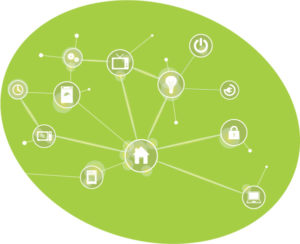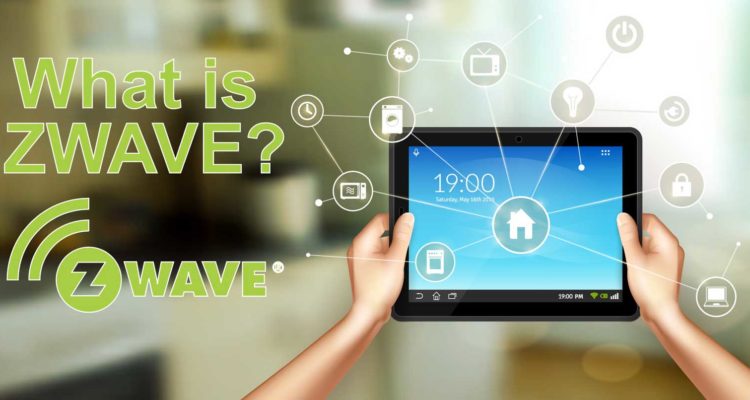If you’ve been searching for ways to add automation to your home, you’ve likely seen Z-Wave mentioned. It’s attached to a number of popular consumer brands and used in homes throughout the world. Unfortunately, there isn’t a lot of information available as to what it is and how it works. Hopefully this guide can help.
What is Z-Wave?
Z-Wave is a wireless technology protocol that allows smart home products to connect with each other. It works in a similar fashion to Wi-Fi or Bluetooth. The technology has been around since 1999 when it was created by Danish company Zensys. Since then it has seen great advancements in its underlying technology.
Only 6 products used Z-Wave back in 2005. Today there are over 2,700 and growing. They are found in products from brands such as GE, First Alert, Schlage, Yale, Honeywell, and more.

How does Z-Wave work?
Z-Wave uses a low-energy radio frequency that operates at 908.42 MHz in North America and 868.42 MHz in Europe. It connects devices using a mesh network (or wireless ad hoc network). Meaning instead of having all your devices connect back to your router, they connect with each other. The more devices in the network, the stronger it becomes.
If a product works with Z-Wave, it will work with any other Z-Wave product regardless of brand. So your GE light switch is compatible with your MyQ garage door opener.
Does Z-Wave need a hub?
Yes. While all Z-Wave devices communicate with each other in a mesh network, they need a home base to relay information back to your internet router. These hubs (or controllers) are sold by various companies and allow you to control all your Z-Wave products in one place through their app.
What are the benefits of Z-Wave?
There are a number of benefits to using Z-Wave over other wireless options like Wi-Fi and Bluetooth. Perhaps the most important is that because each Z-Wave product communicates with each other, it can substantially increase the range. If you are using a Z-Wave garage door, it doesn’t need to connect directly to your hub on the other side of the house. It will instead connect automatically to your front door lock, which might connect to a light switch in a room, which would connect to a smoke detector, which would then connect to the hub. It’s like a big connected chain of Z-Wave products.
Because Z-Wave operates at such a low frequency, it is less susceptible to interference found in Wi-Fi or Bluetooth connections. It can also penetrate doors and walls much better. This is important when devices are used in different rooms and floors.
Since your devices will connect to a hub, it puts less stress on your router. You don’t want 50 devices creating 50 different connections to your router. Instead, your router will receive one connection from the hub providing all the information it needs.
What is the range of Z-Wave?
Z-Wave has an outdoor operating range of 328 feet (100 meters) and an indoor range of 100 feet (30 meters). The closer devices are to one another, the more efficiently they’ll operate.
Does Z-Wave use Wi-Fi?
No. It uses its own low-energy radio frequency. Your main hub though will likely use Wi-Fi.
Is Z-Wave safe?
While no system is full-proof, Z-Wave is quite secure. Each network has a unique ID code that is assigned to the devices so that there is no overlap with a neighbor. Newer products use AES128 encryption. In 2017, their Security 2 framework (S2) was implemented. The most notable change was Z-Wave products would include a unique pairing code with the device. This means you needed the physical device in your possession to access it. A bit like 2-factor authentication we use on our phones.
Will Z-Wave work without internet?
Yes and no. Some rules you set on some devices will work without internet. So if you have your outside lights set to turn on every day at 7pm, that will continue to happen.
As for controlling through your phone, that’s dependent on the hub you’re using. SmartThings Hub for instance will not allow you to make commands as it controls actions through their cloud. The VeraPlus Hub processes requests locally. So if your phone and hub are connected to your router, it does not require internet.
What are some popular hubs?
- Samsung SmartThings Hub
- Wink Hub 2
- Nexia Home Intelligence Bridge
- Insteon Central Controller Hub
- Vera Control VeraEdge
- Vera Control VeraPlus
- Mi Casa Verde VeraLite
Will Z-Wave work with Zigbee products?
The products themselves will not communicate with each other. However, if you are using a hub like the Wink 2 that supports both protocols, you will be able to control them from the same app.
Does Amazon Alexa work with Z-Wave?
Yes, but you’ll need to buy a hub that works with Alexa. Thankfully, most popular ones do. Look at Samsung SmartThings, Wink, or Vera.
Does Z-Wave work with Google Home?
Yes, this is just like Amazon Alexa. You’ll need to make sure your hub is compatible with Google Home Assistant.

